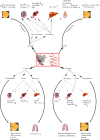Toxicology effects of saffron and its constituents: a review
- PMID: 28293386
- PMCID: PMC5339650
- DOI: 10.22038/ijbms.2017.8230
Toxicology effects of saffron and its constituents: a review
Abstract
Saffron (Crocus sativus L.) has been considered as a medicinal plant since ancient times and also widely used as food additive for its color, taste and odor. The pharmacological properties of saffron and its main constituents, crocin and safranal have been evaluated using different in vivo and in vitro models. Additionally, other lines of studies have found toxicological effects of saffron. However, a comprehensive review that covers all aspects of its toxicity has not been published yet. The current study provides classified information about the toxic effects of saffron and its constituents in various exposure conditions including acute, sub-acute, sub-chronic and chronic studies. Therapeutic doses of saffron exhibits no significant toxicity in both clinical and experimental investigations.
Keywords: Crocetin; Crocin; Saffron; Safranal; Toxicity.
Figures
References
-
- Alavizadeh SH, Hosseinzadeh H. Bioactivity assessment and toxicity of crocin: a comprehensive review. Food Chem Toxicol. 2014;64:65–80. - PubMed
Publication types
LinkOut - more resources
Full Text Sources


